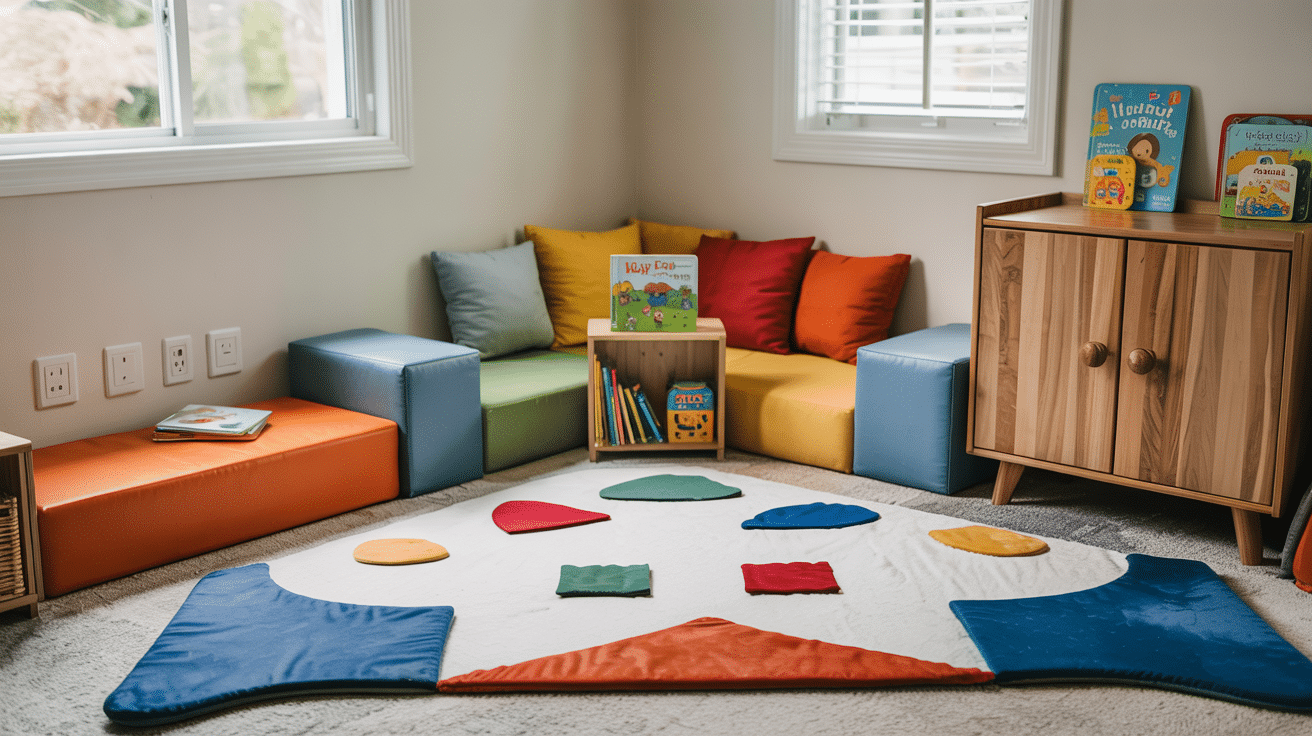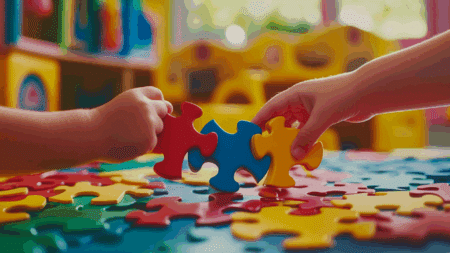Parents often struggle to keep their kids happy and busy in a small home space. Many find it hard to create play areas that work well for both fun and learning.
Children need a good spot to play, but parents also want the room to stay neat.
A well-planned kids’ playroom can solve these problems. It provides children with a space to have fun while helping them develop new skills. Plus, it keeps toys from taking over the entire house!
This guide will show how to make a playroom that kids will love and that makes parents’ lives easier, too.
From smart storage ideas to simple setup tips, readers will find everything needed to build the perfect play space.
How to Plan the Perfect Space for Your Child’s Play

A good play space starts with basic planning. Consider how your child plays now and what they may enjoy as they grow. Each child has their likes, so watch what makes them happy.
The room size matters. You need enough room for kids to move freely. Too much open space can feel cold, while too little can feel tight, aim for a balance.
Think about light, too. Natural light is ideal during the day. Good lamps help on cloudy days or evenings.
Floor choice is key. Soft mats or rugs are ideal for babies and small children. Older kids might need firm floors for building blocks or doing crafts.
Sound is worth thinking about as well. Some kids focus better in quiet spots. Others may need music or background sounds to feel calm.
Planning now saves work later. A well-thought-out play space can be both fun and useful.
Budget-Friendly Kids Playroom Ideas

Creating a fun playroom doesn’t have to cost a lot of money. With a bit of thought and some basic items, you can make spaces that children love.
Many of these ideas utilize items you may already have at home or can find at a low cost. The best part? These simple play areas help kids learn while they have fun.
1. Chalkboard Wall
A chalkboard wall is a creative feature that gives children a space to draw, write, and express their ideas freely. It’s easy to set up with a coat of chalkboard paint and can be updated at any time.
Kids can practice writing, play games, or doodle, making it a versatile addition to any playroom.
The wall is also easy to clean, so kids can start fresh whenever they want.
- Materials required: Chalkboard paint, chalk, paintbrush
- Age group: 3–10
- Learning outcome: Encourages creativity, self-expression, and fine motor skills.
2. Floor Cushions
Floor cushions provide a comfortable spot for kids to sit, read, or play with friends. They are easy to move around and can be stacked when not in use. Choose washable covers for easy cleaning and bright colors to add cheer to the room.
Floor cushions can also double as soft play surfaces for younger children.
- Materials required: Foam inserts, fabric covers, thread
- Age group: 2–12
- Learning outcome: Supports social interaction, relaxation, and gross motor development.
3. DIY Tent
A homemade tent or teepee creates a cozy nook where children can read, nap, or play pretend games. Using fabric and lightweight poles, you can set up a private retreat in any corner of the playroom.
Kids love having a special spot that feels like their own little hideaway.
This setup encourages quiet time and imaginative play.
- Materials required: Fabric, PVC pipes or wooden dowels, connectors
- Age group: 3–8
- Learning outcome: Promotes independence, imaginative thinking, and self-soothing.
4. Magnet Wall
A magnet wall is a fun and interactive way for children to play with letters, numbers, and shapes. Mount a metal sheet on the wall and provide a variety of magnets for endless play possibilities. Kids can create words, solve puzzles, or design patterns, all while standing and moving around.
This activity can be easily refreshed with new magnets.
- Materials required: Metal sheet, magnets, wall mounts
- Age group: 3–7
- Learning outcome: Enhances literacy, problem-solving, and hand-eye coordination.
5. Indoor Swing
An indoor swing adds excitement and movement to the playroom. Securely installed, it offers a safe way for kids to burn off energy, swing back and forth, and enjoy physical activity indoors.
Swings can be made from fabric or wood and should be placed over a soft, padded mat for added safety.
- Materials required: Rope, swing seat, ceiling mount, safety mat
- Age group: 4–10
- Learning outcome: Improves balance, coordination, and core strength.
6. Puppet Stage
A puppet stage, made from a simple box or curtain setup, gives kids a platform for storytelling and role-playing.
Children can put on shows for family and friends, building confidence and communication skills. The stage can be decorated with paint or fabric to match the playroom’s theme.
- Materials required: Cardboard box or frame, fabric, paint
- Age group: 3–9
- Learning outcome: Develops language skills and social interaction.
7. Mini Climbing Wall
A small climbing structure with handholds can bring adventure to the playroom. Be sure to install it over soft mats for safety. This feature helps kids build strength and coordination while having fun. It also encourages problem-solving as they figure out how to reach the top.
- Materials required: Climbing holds, plywood, screws, safety mats
- Age group: 4–8
- Learning outcome: Builds physical strength, coordination, and problem-solving abilities.
8. Play Mat Roads
A play mat with printed roads is a simple way to inspire creative play with toy cars and trucks. Kids can create stories and scenarios as they drive their vehicles around the mat. It is easy to roll up and store when not in use. This mat provides a defined play area, encouraging imaginative thinking.
- Materials required: Play mat with road design, toy cars
- Age group: 2–7
- Learning outcome: Enhances storytelling, spatial reasoning, and fine motor skills.
9. Box Castle
Large cardboard boxes can be transformed into a castle for pretend play. Cut out windows and doors and let kids decorate it with paint and markers. This encourages creativity and collaboration as they work together to build their fortress. It also provides a fun space for them to act out stories and scenarios.
- Materials required: Cardboard boxes, paint, markers, tape
- Age group: 3–8
- Learning outcome: Fosters creativity, teamwork, and imaginative play.
10. Costume Corner
A costume corner with a mirror and dress-up clothes encourages role-playing and creativity. Kids can try on different outfits and pretend to be other characters, building their confidence and communication skills. This area can be as simple as a few hooks and a basket of clothes.
- Materials required: Costumes, mirror, hooks, or rack
- Age group: 3–7
- Learning outcome: Builds confidence, social skills, and creative thinking.
11. Book Space
A cozy reading area is an addition to any playroom. Fill it with soft pillows, blankets, and shelves with a variety of books. Kids can relax and read in comfort, fostering a lifelong love of reading. Ensure that you include books that are both age-appropriate and interesting to them.
- Materials required: Pillows, blankets, bookshelves, books
- Age group: 3–10
- Learning outcome: Encourages reading habits, focus, and language development.
12. Craft Station
A dedicated craft station, complete with a table and art supplies, inspires creativity and self-expression. Provide paper, crayons, paint, and other materials for kids to create their masterpieces.
This area helps develop fine motor skills and hand-eye coordination.
- Materials required: Table, chairs, art supplies (paper, crayons, paint, glue)
- Age group: 4–12
- Learning outcome: Boosts creativity, fine motor skills, and self-expression.
13. Hanging Art Display
Showcase children’s artwork by creating a hanging display. Use string and clips or frames to hang their creations on the wall. This makes them feel proud of their work and adds a touch of color to the playroom.
It also encourages them to continue creating new pieces.
- Materials required: String, clips or frames, artwork
- Age group: 3–12
- Learning outcome: Builds confidence, self-esteem, and creativity.
14. Sensory Bin
A sensory bin filled with rice, beans, or sand provides tactile stimulation and exploration. Kids can scoop, pour, and play with the materials, developing their fine motor skills and sensory awareness. Add small toys or objects for them to find and sort.
- Materials required: Plastic bin, filler material (rice, beans, sand), small toys
- Age group: 2–6
- Learning outcome: Supports sensory development, fine motor skills, and exploration.
15. Building Zone
A building zone with blocks or magnetic tiles encourages construction and spatial reasoning. Kids can build towers, houses, and other structures, developing their problem-solving skills and hand-eye coordination. Offer a variety of sizes and shapes to enhance play possibilities.
- Materials required: Blocks, magnetic tiles
- Age group: 3–9
- Learning outcome: Develops spatial skills, problem-solving, and hand-eye coordination.
16. Imagination Corner
An imagination corner with dress-up clothes and props sparks creative role-playing. Kids can pretend to be anything they want, from firefighters to doctors to superheroes. This encourages them to use their imagination and develop their social skills.
- Materials required: Costumes, props, storage bin
- Age group: 3–8
- Learning outcome: Encourages storytelling, empathy, and social skills.
17. Reading Nook
A small tent or teepee with cushions creates a cozy reading nook. Kids can curl up with a book and enjoy a quiet moment. This provides a quiet space for them to relax and focus on reading.
- Materials required: Fabric, cushions, books
- Age group: 3–10
- Learning outcome: Promotes literacy, relaxation, and focus.
18. Toy Rotation Bins
Use bins to rotate toys and keep play fresh. By only making a few toys available at a time, you can help kids stay engaged and prevent them from becoming overwhelmed. Store the other toys in bins and rotate them regularly.
- Materials required: Storage bins
- Age group: 2–8
- Learning outcome: Teaches organization and decision-making.
19. Wall Decals
Removable wall decals add color and interest to the playroom without paint. Kids can help choose and apply the decals, personalizing their play space. They are easy to remove and reposition, so you can change the decor as their interests evolve.
- Materials required: Wall decals
- Age group: 2–10
- Learning outcome: Provides a stimulating environment and encourages personalization.
20. Puzzle Station
Create a station dedicated to puzzles, offering a variety of jigsaws and brain-teasers suitable for different ages. Puzzles enhance problem-solving abilities, improve spatial reasoning, and boost concentration. Keep puzzles organized using storage racks or containers, and change them periodically to maintain interest.
- Materials required: Puzzles, storage containers or racks
- Age group: 3-10
- Learning outcome: Improves problem-solving skills, spatial reasoning, and concentration.
21. Music Wall
Construct a music wall using recycled materials like pots, pans, and metal pipes. Children can bang, tap, and create their own rhythms, exploring sounds and developing their musicality. Ensure all materials are safely secured to the wall.
- Materials required: Recycled metal items, screws, wooden board
- Age group: 3-12
- Learning outcome: Encourages musical appreciation, rhythm recognition, and creativity.
22. Bean Bag Toss
Set up a bean bag toss game using a wooden board with holes or buckets. This activity improves hand-eye coordination and motor skills, while also teaching kids about distance and aiming. Decorate the board with bright colors and numbers for added educational value.
- Materials required: Bean bags, wooden board or buckets
- Age group: 3-8
- Learning outcome: Improves hand-eye coordination, motor skills, and math skills.
23. Nature Table
Create a nature table where kids can display natural items they find outdoors, like leaves, stones, and shells. This fosters an interest in nature and science. Provide magnifying glasses and books about nature to enhance their learning experience.
- Materials required: Table, natural items, magnifying glasses, nature books
- Age group: 4-10
- Learning outcome: Fosters an interest in nature, science, and observation skills.
24. DIY Obstacle Course
Design an indoor obstacle course using pillows, blankets, tunnels, and furniture. This helps children develop gross motor skills, balance, and coordination. Change the course regularly to keep it interesting and challenging.
- Materials required: Pillows, blankets, tunnels, furniture
- Age group: 3-8
- Learning outcome: Develops gross motor skills, balance, and coordination.
25. Dress-Up Trunk
Fill a trunk with old clothes, hats, shoes, and props for imaginative play. Children can dress up as various characters and act out stories, thereby boosting their confidence and social skills.
Encourage them to create their own costumes and scenarios.
- Materials required: Old clothes, hats, shoes, props, trunk
- Age group: 3-7
- Learning outcome: Enhances imagination, social skills, and self-expression.
26. Dance Area
Create a designated dance area with a mirror and a music player. Kids can dance, move, and express themselves through movement. This promotes physical activity, coordination, and self-confidence. Add ribbons or scarves for added fun.
- Materials required: Mirror, music player, ribbons or scarves
- Age group: 3-12
- Learning outcome: Promotes physical activity, coordination, and self-confidence.
27. Lego Station
Dedicate a space for Lego building with a table, baseplates, and storage containers. Legos enhance fine motor skills, spatial reasoning, and problem-solving abilities. Provide a variety of Lego sets and encourage kids to build their own creations.
- Materials required: Lego bricks, table, baseplates, storage containers
- Age group: 4-12
- Learning outcome: Enhances fine motor skills, spatial reasoning, and problem-solving abilities.
28. Science Experiment Corner
Set up a science experiment corner with simple supplies like baking soda, vinegar, and food coloring. Kids can conduct simple experiments and learn about scientific concepts. Provide instructions and supervision to ensure safety.
- Materials required: Baking soda, vinegar, food coloring, containers
- Age group: 5-12
- Learning outcome: Introduces scientific concepts, critical thinking, and cause-effect relationships.
29. Sensory Table
A sensory table can be filled with a variety of materials such as water, sand, rice, or dry pasta. Children can explore textures, temperatures, and volumes, enhancing their sensory development. Add tools like cups, spoons, and funnels for interactive play.
- Materials required: Table, water, sand, rice, dry pasta, tools
- Age group: 2-6
- Learning outcome: Develops sensory awareness and enhances fine motor skills.
30. Fort Building Supplies
Keep a basket filled with blankets, clips, and pillows readily available for fort building. Forts encourage problem-solving and teamwork. Kids can create their own secret hideaways and act out stories.
- Materials required: Blankets, clips, pillows, basket
- Age group: 3-10
- Learning outcome: Encourages problem-solving and teamwork.
31. Car and Truck Ramp
Build a ramp out of wood or cardboard for toy cars and trucks. This helps children understand concepts like gravity, speed, and distance. They can race cars down the ramp and experiment with different angles and surfaces.
- Materials required: Wood or cardboard, toy cars, and trucks
- Age group: 3-7
- Learning outcome: Teaches basic physics concepts and improves hand-eye coordination.
32. Rock Painting Station
Set up a rock painting station with smooth rocks, paint, and brushes. Kids can paint and decorate the rocks, allowing them to express their creativity.
This activity enhances fine motor skills and provides a tangible result they can display.
- Materials required: Smooth rocks, paint, brushes
- Age group: 4-10
- Learning outcome: Enhances fine motor skills, creativity, and self-expression.
33. Storytelling Basket
Fill a basket with props like puppets, figurines, and small toys to inspire storytelling. Children can use the props to create their own stories, developing their language skills. This activity promotes creativity and builds confidence.
- Materials required: Puppets, figurines, small toys, a basket
- Age group: 3-8
- Learning outcome: Develops language skills and builds confidence.
34. Board Game Collection
Keep a collection of board games suitable for different ages and interests. Board games promote social interaction, problem-solving, and critical thinking. Schedule regular game nights to encourage family bonding.
- Materials required: Board games
- Age group: 4-12
- Learning outcome: Promotes social interaction, problem-solving, and critical thinking.
35. Paper Airplane Launcher
Build a paper airplane launcher using cardboard tubes and rubber bands. Children can fold paper airplanes and launch them, experimenting with aerodynamics. This activity teaches basic physics concepts and encourages experimentation.
- Materials required: Cardboard tubes, rubber bands, paper
- Age group: 5-12
- Learning outcome: Teaches basic physics concepts and encourages scientific thinking.
36. Letter and Number Scavenger Hunt
Organize a letter and number scavenger hunt using magnetic letters and numbers. Hide them around the playroom and have kids find them. This activity reinforces letter and number recognition and promotes physical activity.
- Materials required: Magnetic letters and numbers
- Age group: 3-6
- Learning outcome: Reinforces letter and number recognition and promotes physical activity.
37. Glow-in-the-Dark Fun
Add glow-in-the-dark stickers, paint, and toys to the playroom for nighttime fun. Kids can create glowing artwork, play with bright toys, and enjoy a unique sensory experience. This activity sparks curiosity and provides a magical atmosphere.
- Materials required: Glow-in-the-dark stickers, paint, toys
- Age group: 3-10
- Learning outcome: Sparks curiosity and provides sensory stimulation.
38. Shadow Puppet Theater
Create a shadow puppet theater using a cardboard box and a source of light. Kids can create shadow puppets and put on shows, developing their language skills. This activity promotes creativity and encourages storytelling.
- Materials required: Cardboard box, light source, puppets
- Age group: 4-10
- Learning outcome: Develops language skills and encourages storytelling.
39. Pattern Blocks
Provide pattern blocks in different shapes and colors for children to create patterns and designs. Pattern blocks enhance spatial reasoning, fine motor skills, and creativity. They can also be used to teach basic math concepts.
- Materials required: Pattern blocks
- Age group: 3-8
- Learning outcome: Enhances spatial reasoning, fine motor skills, and creativity.
40. Marbling Station
Set up a marbling station with shaving cream and food coloring. Kids can create marbled paper and artwork, experimenting with colors and patterns. This activity enhances fine motor skills and provides a sensory experience.
- Materials required: Shaving cream, food coloring, paper
- Age group: 4-12
- Learning outcome: Enhances fine motor skills and provides a sensory experience.
41. Obstacle Course Challenge Cards
Create challenge cards for an obstacle course with tasks like “crawl under the table” or “jump over a pillow.” Kids can pick a card and complete the task, making the obstacle course more challenging. This promotes problem-solving, creativity, and physical fitness.
- Materials required: Index cards, markers
- Age group: 3-8
- Learning outcome: Promotes problem-solving, creativity, and physical fitness.
Getting the Kids Involved in The Design Process

When you let your kids help plan their play space, they feel valued and learn to make choices. Children who participate in designing their rooms often use the space more and help keep it clean.
Kids know what they like. Even young children can tell you their favorite things. Ask them about colors they enjoy or toys they use most. Their input helps create a room they’ll truly love.
Here’s how to make kids part of the planning:
- Ask what they like about the current play spots
- Show them simple pictures of kids playroom for ideas
- Let them pick from 2-3 color options you pre-select
- Take them shopping to choose small items
- Have them test furniture for comfort before buying
Keep the choices simple. Too many options can make kids feel lost. For a three-year-old, asking “blue or green?” is more effective than “what color do you want?”
Listen to their ideas, but also guide them. Your child might want a ball pit in the middle of the room. You can say yes to the ball pit, but place it where it makes sense for the full room plan.
This team effort teaches kids about planning and gives them a sense of pride in their space. The result? A room that works for everyone.
Essential Safety Tips for Every Playroom

Safety doesn’t mean taking away the fun. It means creating a space where kids can play freely without hidden risks. Here are key safety tips to keep in mind:
- Cover all power outlets with safety plugs when not in use
- Secure tall furniture to the walls to prevent tipping
- Check for small parts in toys that could cause choking
- Use soft corner guards on sharp table and shelf edges
- Keep cords from blinds or curtains out of reach
- Choose non-toxic paints and materials for walls and floors
- Install baby gates if needed for very young children
- Make sure all storage units can’t be pulled over easily
Wrapping It Up
Creating a playroom doesn’t need expensive items or big spaces. The kids playroom ideas we’ve shared can work in any home, with any budget. The key is to think about what your child enjoys and how they play.
Try starting with just one or two ideas from our list.
See how your kids respond, then add more options over time. Remember that the best playrooms grow with your child and can be changed as they get older.
What matters most is making a space where kids feel safe to play, learn, and use their imagination.
So, which idea will you try first? Leave a comment below to share your plans or show us your playroom creations!




